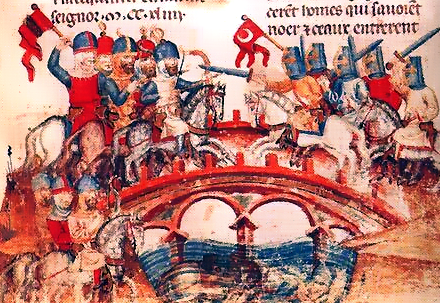The Mongols menaced Latin Christendom on two fronts: in Eastern Europe and in Outremer. The first reports of the attack on the Khwārazmian Empire, reaching Egypt in 1221, prompted the commanders of the Fifth Crusade (1217– 1221) to identify the newcomers with the long-awaited forces of the great Eastern king Prester John, though news of the defeat of the Cumans and their Russian allies on the Kalka River (1223) was less encouraging. The Mongols attacked the Latin world only after the sack of Kiev (December 1240). While Batu himself and three separate armies entered Hungary, two divisions protected his flank by ravaging Poland, where they crushed Duke Henry II of Silesia and his allies near Liegnitz (mod. Legnica, Poland) on 9 April 1241; ravaging the borders of Saxony and Bohemia, they then passed through Moravia into Hungary. Here King Béla IV was overwhelmed at Mohi near the Sajó River on 11 April and fled toward the Adriatic coast while the Mongols devastated his kingdom east of the Danube. In January 1242 they crossed the frozen river and harassed the western provinces before retiring into the steppes north of the Black Sea. In the Near East, the general Baiju sent a division into northern Syria in the summer of 1244: various Ayübid Muslim rulers promised tribute, but Prince Bohemund V of Antioch defiantly rejected an ultimatum. One important consequence of this advance was that several thousand Khwārazmian horsemen, displaced from northern Iraq, moved south and sacked Jerusalem in August 1244 before joining forces with the Egyptian sultan and crushing the Franks and their Muslim allies at La Forbie in October.
The Mongol attacks of the 1240s threw into relief the disharmony and unpreparedness of the West, where the Mongol menace had perhaps not been taken sufficiently seriously. Pope Gregory IX and the Emperor Frederick II were unwilling to sink their differences in order to cooperate against the Mongols, and a crusade mustered in Germany in 1241 dissolved before it could make contact with the invaders. Not until the pontificate of Innocent IV (1243– 1254) did the Curia endeavor to negotiate with the enemy. Innocent dispatched three separate embassies—two, comprising Dominican Friars, to the Near East and a third, composed of Franciscans, through the Russian steppes— with letters protesting at the attacks on Christian nations and urging the Mongols to accept the Christian faith. The reports submitted by these friars in 1247 furnished the papacy with its first full dossier of information on the enemy, and they are among our most important Western sources, particularly that of the Franciscan John of Piano Carpini, who visited the court of the Great Khan Güyüg. But this aside, they achieved little more than espionage, merely bringing back ultimatums that required the pope’s submission. When in 1248 the general Eljigidei, who had superseded Baiju in north-western Persia, sent a cordial message to the French King Louis IX in Cyprus, its moderate tone occasioned great excitement in the West; but most probably its aim was merely to deflect Louis’s crusading army from territories on which the Mongols had immediate designs. At this time, the Mongols had no allies, only subjects—or enemies awaiting annihilation.
